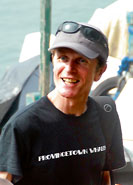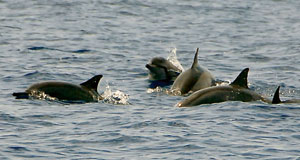Philip Hoare is about to see his first blue whale.
There, five miles out, the towering spout rises like a fountain in the middle of the undulating expanse. The height and width of this column of condensed breath (with traces of seawater and whale ‘snot’) is unique to this giant mammal. In a time when whalers trawled the ocean it would have been the first sign that they had found prey worth chasing. On this day, however, it sends a ripple of excitement through the fifty odd tourists who’ve come so far in pursuit of a simple sighting. We’re guided by that distant spray, but they’re travelling so fast that the whales almost leave us behind. When we finally manage to crawl up alongside, we see no less than six animals, one of whom is a young calf, perhaps just a year old. It is still learning to dive, and lingers behind its mother as she flukes, arrowing straight down into the deep.
 |
| Philip Hoare |
Philip is so happy, he’s almost squeaking. His wide grin breaks out as he tells us that he’s spent 10 years whale watching and he’s never gotten close to a blue whale before. “Other people today are in offices, they’re working, they’re doing the shopping in supermarkets...but you were out seeing blue whales... I’ve never seen a blue whale up until a few hours ago, and now we’ve seen six!” he says.
In case you were wondering, Philip isn’t a marine biologist. What he is, is an author obsessed with his subject. Having won the Samuel Johnson prize for his extraordinary book, ‘Leviathan or the Whale’, Philip has spent several years immersed in the study of these animals. The book is a delightful read as the author goes wherever curiosity and coincidence take him – from stories of giant squid and sperm whales locked in epic battles, to the room in which Herman Melville sits writing a letter to Nathaniel Hawthorne after the publication of Moby Dick.
Despite his great love for the whales, Philip also takes a clear- eyed, objective look at the industry of whaling. He visits old whaling boats and describes the planks soaked in oil, tells tales of men swallowed alive, of how the blubber of whales chased away the dark in thousands of homes, and of whales that turned on their pursuers – with one white whale bringing down its heavy tail on a wooden boat full of seamen. He also unearths the most extraordinary research. He reports that Hal Whitehead, who began studying sperm whales off the coast in Trincomalee, believes that whales might be so advanced that they are capable not only of great self awareness but that the population also participates in a form of religion.
Whales remain a mystery to us, says Philip, pointing out that we have no idea where that calf before us was born, or where it was conceived. Blue whales, the largest mammal and perhaps the largest animal ever to live on earth, continue to elude us routinely. Even now, we wait for the mother to resurface. The expanse of ocean remains unbroken by the sleek lines of an inky blue body, and so Philip thinks the animal is somewhere many feet below us feasting on tiny krill. If you were under the water with them you would see their mouths fall open and their pleated bellies expand like accordions as they swallow enormous quantities of seawater in a single gulp. “And then like some kind of pasta strainer, it contracts and pushes the sea water out through the baleen,” says Philip. Edged with baleen hair, baleen or whalebone serves as a sieve, filtering out krill.
A single whale can eat six tonnes of these tiny shrimp. “A whale is taking in enormous amounts of calories to sustain its bulk, explains Philip adding that “a mother like the mother we saw today is also making all that milk to feed her calves. It’s really a great drain on her resources.” Whales hunt out the football sized patches of krill that can be found along the edge of the continental shelf. Some patches of water seem slick, calmer than others. Here shallower warm water colliding with water from the icy depths summons up an upwelling current rich in the nutrients that sustain plankton. And where there is plankton, you’ll find krill. “Today we went over the continental shelf. If we had see-through water, we’d have all had an attack of vertigo. We plunged from a few hundred feet to thousands of feet down - we went over a cliff edge,” says Philip, explaining that these are key places for whales.
 |
| Spotting a pod of Dolphins |
Of the stern of the boat, an excited voice announces that the whales are back up and everyone crowds to the railing. Later, (he doesn’t believe in distracting from the actual sighting of a whale) Philip will observe, “You’d have to be pretty silly to not realise that that was a huge animal.” It does take awhile – we see approximately 23 metres of that sleek body between that first spout until that elegant tail flicks the air before disappearing. “It just took so long, you could count almost five or ten before the animal had disappeared,” says the author.
With a spout that reaches higher than a house, blue whales are distinguished by more than their size. For instance, it’s easy to confuse a minke whale’s spouting with it sneezing, a humpback has a ‘bushy’ spout and a right whale has a v shaped blow. A blue whale’s colour, which Philip describes as a “deep iridescent petrolly blue,” is mottled with patches of gray, blue and black – the exact placement of which is unique to each whale, some of whom live to be over 140 years old. “The other old whaling name for a blue whale was ‘sulphur bottom’,” says Philip explaining that the inelegant name was coined for the diatom parasites that clung to the belly of the whale giving its underside a yellowish cast.
I never see the diatoms for myself and Philip notes we only saw a tantalising glimpse, a small sliver of the behemoth swimming near us. Philip, who has swum with whales, writes of how he once hung in the water in the path of an oncoming whale. Their sight is known to be poor, and Philip found himself wondering, terrified, if he would be simply run over. But whales live their lives immersed in their sense of sound, and it simply dived straight down in front of him.
Philip has seen 22 of the 85 different species of whale and now he’s talking about how much whales rely on echolocation (blue whales are among the loudest in the ocean) and how human sonar can sound like dynamite in the underwater environment. Disorienting waves sent out by military equipment can severely disorient them, causing them to strand themselves on the beach. (Severe storms can have the same effect.)
Now, even with our benevolent intentions, boats chasing whales can end up hurting them as propellers carve chunks out of tails and fins. Besides the whales, we also came across a pod of striped dolphins. Unlike their frolicking cousins, the rarer striped dolphins are shy and do not approach the boat. It’s the first time our crew have seen them this season. Still, on this trip, we take great care to keep a safe distance, and Philip says it should be a practice that is enforced by law.
The number of hopeful visitors is sure to swell. He imagines that news of such sightings will galvanise the international community with whale watchers, researchers and conservationists beating a path to Mirissa. These are endangered animals.“There are probably fewer than 15,000 of these animals globally in every ocean,” says Philip.
Our trip is hosted by Jetwing Lighthouse, and Philip says the organisation is keen on lobbying the government to create guidelines that will protect whales. Explaining that he has been in talks with the head of the hotel, Philip says: “We go out there because we love these animals and we don’t want to see them damaged - how awful if it is our actions that damage them.” |



